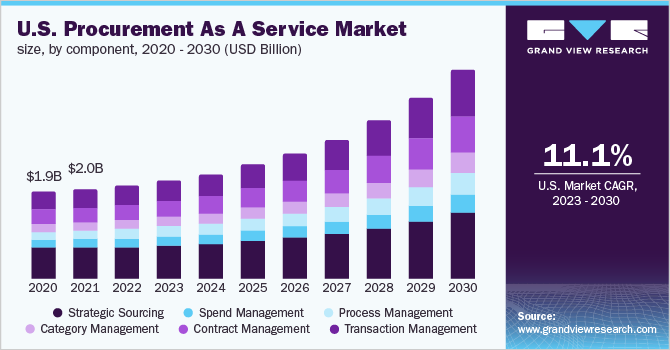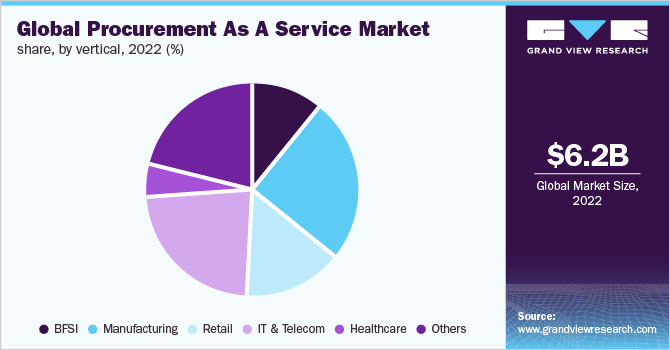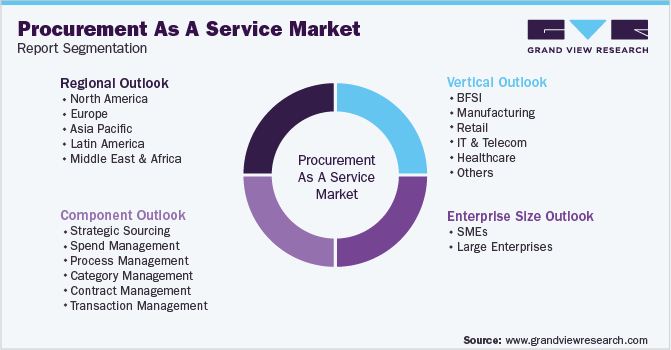- Home
- »
- Communication Services
- »
-
Procurement As A Service Market Size & Share Report, 2030GVR Report cover
![Procurement As A Service Market Size, Share & Trends Report]()
Procurement As A Service Market Size, Share & Trends Analysis Report By Component (Strategic Sourcing, Category Management), By Enterprise Size, By Vertical, By Region, And Segment Forecasts, 2023 - 2030
- Report ID: GVR-4-68038-121-4
- Number of Report Pages: 105
- Format: PDF, Horizon Databook
- Historical Range: 2018 - 2021
- Forecast Period: 2023 - 2030
- Industry: Technology
Report Overview
The global procurement as a service market size was valued at USD 6.15 billion in 2022 and is expected to register a growth of 11.1% from 2023 to 2030. As firms increasingly rely on digitization to carry out their sourcing and procurement tasks while keeping track of company payments and purchases, procurement as a service is gaining popularity throughout the globe. Following the COVID-19 pandemic, the uptake of digitization in automating essential business operations like sourcing and procurement is receiving attention. This is anticipated to support the procurement growth as a service market throughout the projection period. Sustainable procurement and supplier relationship management can become more proactive and effective with technology integration; this is expected to enable the economy of scale and boost corporate profitability. As a provider of procurement services, it is crucial to ensure that the newest technologies are used to help businesses anticipate greater accuracy regarding procurement and sourcing. Over the projected period, it is expected to maintain market demand for procurement as a service.

To reduce supply risks and eventually streamline capital and cash flows, there is a rising demand for digital, agile, collaborative, and plug-and-play services as the world recovers from the COVID-19 epidemic. According to estimates, the COVID-19-induced uncertain times will digitally change procurement services, which will fuel the expansion of the market for procurement as a service throughout the projection period. Despite the pandemic's negative effects on demand during 2020, which included businesses ceasing production operations amid lockdown regulations and slashing expenses, the comeback in 2021 has been respectable. By the end of 2022, it is predicted that the procurement as a service market will have recovered to pre-COVID-19 levels as commercial activity picks up throughout the world.
Global supply chains update and streamline procedures to increase productivity and operational effectiveness. It is predicted that this will result in a rise in the need for cloud-based procurement services. Through upcoming new technologies, there is an increasing requirement to enhance procurement processes within firms; this will be crucial in driving market demand over time. Service providers saw the shortcoming of the procurement service owing to the current epidemic, which has caused traditional procurement strategies to fail to scale and become unsustainable. The importance of global procurement services providing organizations has changed in light of this new status quo, moving away from negotiating service contracts and toward exclusive business alliances and strategic arrangements to guarantee both long- and short-term business. Similar to the supply side, business understanding of procurement procedures and services has grown significantly during the past few years. Custom service offers have evolved into a differentiator for service providers, promoting the expansion of procurement as a service industry.
The adoption of cloud-based deployment methods is complex, slowing the market's expansion rate. Furthermore, the adoption of cloud-based procurement as a service, owing to its expensive nature, is restricted to large-scale businesses, which is further expected to hinder the market growth. Additionally, inadequate awareness in emerging economies and expensive implementation costs of the services has been restricting its uptake in growing economies. The market growth rate will further be impacted by third-party dependence, weak infrastructure, and network outages in developing economies.
Component Insights
The strategic sourcing segment accounts for the largest market share of over 30% in 2022. The advancement of technology has made strategic sourcing and supply management more effective, enabling businesses to reduce costs and boost profitability. The market will be driven in the upcoming years by the growing demand to develop procurement functions within firms with the help of technologies. For instance, in April 2022, TATA Consultancy Services Limited partnered with Financial Ombudsman Service, a U.K Ombudsman. The Ombudsman and TATA Consultancy Services (TCS) have collaborated to improve and future-proof the capabilities of TCS's digital services, assist it in eliminating grievances and discrimination, and better serve and support its clients. TCS will develop a new digital platform that will enhance the user experience for petitioners and responses to enable the Ombudsman's technological capabilities to be future-proofed.
The transaction management segment is anticipated to register significant growth over the forecast period. The segment growth can be attributed to the efficiency offered by transaction management, which enables end-users to increase their profitability of the company while establishing long-term business relationships with suppliers. In the coming years, segment growth is anticipated to be fueled by companies' increasing focus on improving price and terms, sales orders, delivery, and invoicing apps as a component of the overall transaction process. The segment growth is also driven by increasing automation and the expanding demand for market suppliers to help businesses grasp the complicated aspects of a commercial transaction environment. These factors are fostering the growth of the software segment over the forecast period.
Enterprise Size Insights
The large enterprises segment captured a major market share of over 70% in 2022. Large companies will continue to engage in these services to manage complex contractual agreements and bag agreements, thereby taking a substantial piece of the total revenue share. These services are preferred by big businesses because they reduce operating expenses while removing business complexity.
Over the projected period, the small and medium-sized business (SMEs) segment is anticipated to increase significantly. To enable quick decisions, small and medium-sized businesses have been seen changing their attention from general operations management to business process management. As a result, there has been an increase in demand for procurement as a service model throughout the SME sector globally. Additionally, the growing requirement for organizations to enhance their internal procurement procedures to streamline and standardize the complete operation is anticipated to drive the segment's expansion throughout the projected period.
Vertical Insights
The manufacturing industry accounts for the largest market share of over 24% in 2022. Managing supply chains with shorter lead times will contribute largely to the segment growth. Manufacturing will continue to be the highest demand driver for procurement as a service market till 2030. The services in the manufacturing sector will focus on improving supply chain dynamics in relation to direct inputs and raw materials.

The retail sector accounted for a considerable share in 2022 and is anticipated to register considerable growth over the forecast period. The retail sector is customer-oriented, characterized by dynamic industry trends stemming from evolving customer requirements and spending patterns. In the retail environment, these services help align several operations while maximizing returns on investment. Further, with the integration of newer technologies such as AI and machine learning, the procurement service offerings will provide many additional service features, including analytics, to the end-user, subsequently creating avenues for future growth. In addition to new technologies, unprecedented growth in the eCommerce sector in the light of the pandemic will also favor procurement as a service market growth in the long run.
Regional Insights
The European region holds the largest market share of over 40% of the overall revenue share in 2022. The European market has reached maturity with expected modest growth over the forecast period. The increasing focus of procurement service providers in offering customized service plans to their customers and rising demand from European manufacturing enterprises for enhancing the procurement process are key factors driving regional growth. In addition, the growing demand for modernized solutions that could help organizations make data-driven decisions for managing procurement operations is also observed as a trending factor contributing to market growth.

The Asia Pacific region is expected to grow with the fastest CAGR, owing to a considerable rise in demand for digital solutions to manage and streamline supply chain operations. Also, growing internet usage for direct and indirect procurement services is facilitating the adoption of procurement as a service in this region. Additionally, in countries such as China and India, where supply markets are strict, the demand for new sources of supply has emerged rapidly in the region. To manage the new sources, demand for procurement as a service solution is expected to grow considerably over the forecast period.
Key Companies & Market Share Insights
Genpact, Aegis Company, Infosys Limited, GEP, and Wipro Limited are some of the major players in the procurement as service market landscape. The vendors are following the trend of providing subscription-based, industry-specific, and custom-based services & solutions to their clients. The competitor is also resorting to organic and inorganic growth strategies such as mergers, acquisitions, product launches, and partnerships as a way to gain market share in different regions and in the market as a whole. Some of the key players operating in the procurement as a service market include:
-
Accenture plc
-
Aegis Company
-
Genpact
-
GEP
-
HCL Technologies Ltd
-
Infosys Limited
-
International Business Machines Corporation
-
Tata Consultancy Services Limited
-
Wipro Limited
-
WNS (Holdings) Ltd.
Procurement As A Service Report Scope
Report Attribute
Details
Market size value in 2023
USD 6.49 billion
Revenue forecast in 2030
USD 13.58 billion
Growth rate
CAGR of 11.1% from 2023 to 2030
Base year for estimation
2022
Historical data
2018 - 2021
Forecast period
2023 - 2030
Quantitative units
Revenue in USD million and CAGR from 2023 to 2030
Report coverage
Revenue forecast, company ranking, competitive landscape, growth factors, and trends
Segments covered
component; enterprise size; vertical; region
Regional scope
North America; Europe; Asia Pacific; Latin America; MEA
Country scope
U.S.; Canada; U.K.; Germany; China; India; Japan; Brazil; Mexico
Key companies profiled
Accenture plc; HCL Technologies Ltd; Aegis Company
GEP; International Business Machines Corporation; Infosys Limited; Genpact; Wipro Limited; WNS (Holdings) Ltd.; Tata Consultancy Services Limited
Customization scope
Free report customization (equivalent up to 8 analysts working days) with purchase. Addition or alteration to country, regional & segment scope.
Pricing and purchase options
Avail customized purchase options to meet your exact research needs. Explore purchase options
Global Procurement As A Service Market Segmentation
This report forecasts revenue growth at global, regional, and country levels and provides an analysis of the latest industry trends in each of the sub-segments from 2018 to 2030. For the purpose of this study, Grand View Research has segmented the global procurement as a service market report on the basis of component, enterprise size, vertical, and region:

-
Component Outlook (Revenue, USD Million, 2018 - 2030)
-
Strategic Sourcing
-
Spend Management
-
Process Management
-
Category Management
-
Contract Management
-
Transaction Management
-
-
Enterprise Size Outlook (Revenue, USD Million, 2018 - 2030)
-
SMEs
-
Large Enterprises
-
-
Vertical Outlook (Revenue, USD Million, 2018 - 2030)
-
BFSI
-
Manufacturing
-
Retail
-
IT & Telecom
-
Healthcare
-
Others
-
-
Regional Outlook (Revenue, USD Million, 2018 - 2030)
-
North America
-
U.S.
-
Canada
-
-
Europe
-
U.K.
-
Germany
-
-
Asia Pacific
-
China
-
India
-
Japan
-
-
Latin America
-
Brazil
-
Mexico
-
-
Middle East & Africa (MEA)
-
Frequently Asked Questions About This Report
b. Europe led the global market for procurement as a service capturing over 40% of the overall revenue share in 2022. The increasing focus of procurement service providers in offering customized service plans to their customers and rising demand from European manufacturing enterprises for enhancing the procurement process are key factors driving regional growth.
b. Some key players operating in the procurement as a service market include Accenture; HCL Technologies Limited; IBM; GEP; Tata Consultancy Services Limited; WNS (Holdings) Ltd; Wipro Limited; Infosys Limited; and Genpact.
b. Key factors that are driving the procurement as a service market growth include the proliferation of digital technologies, transformation in business supply chains, and rise in procurement outsourcing.
b. The global procurement as a service market size was estimated at USD 6.15 billion in 2022 and is expected to reach USD 6.49 billion in 2023.
b. The global procurement as a service market is expected to grow at a compound annual growth rate of 11.1% from 2023 to 2030 to reach USD 13.58 billion by 2030.
Share this report with your colleague or friend.
![gvr icn]()
NEED A CUSTOM REPORT?
We can customize every report - free of charge - including purchasing stand-alone sections or country-level reports, as well as offer affordable discounts for start-ups & universities. Contact us now
![Certified Icon]()
We are GDPR and CCPA compliant! Your transaction & personal information is safe and secure. For more details, please read our privacy policy.
We are committed towards customer satisfaction, and quality service.
"The quality of research they have done for us has been excellent."





